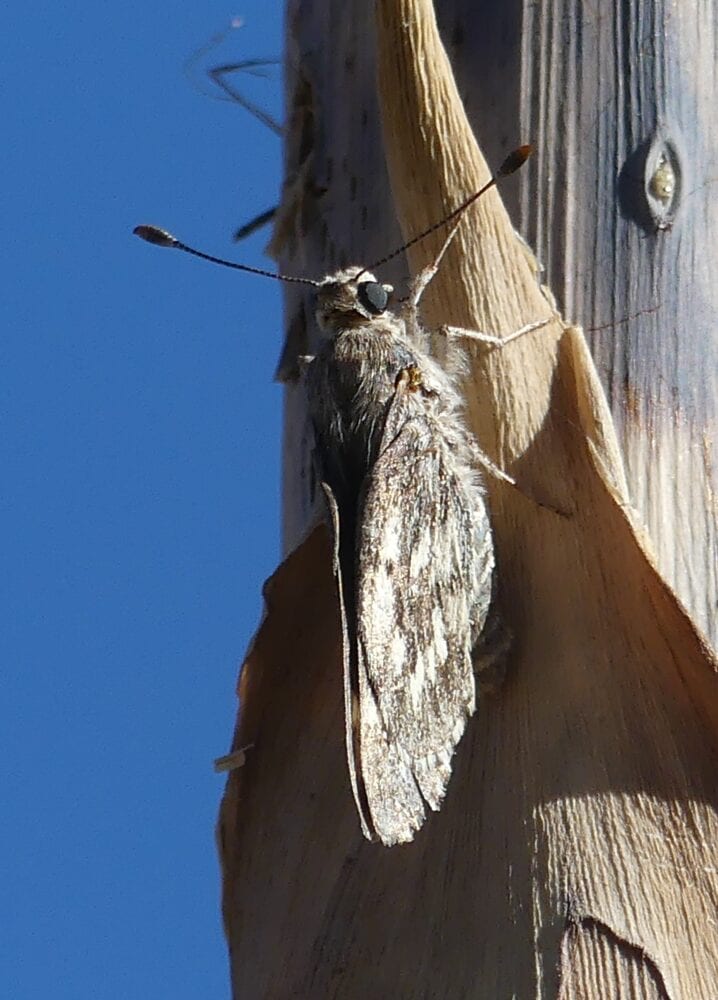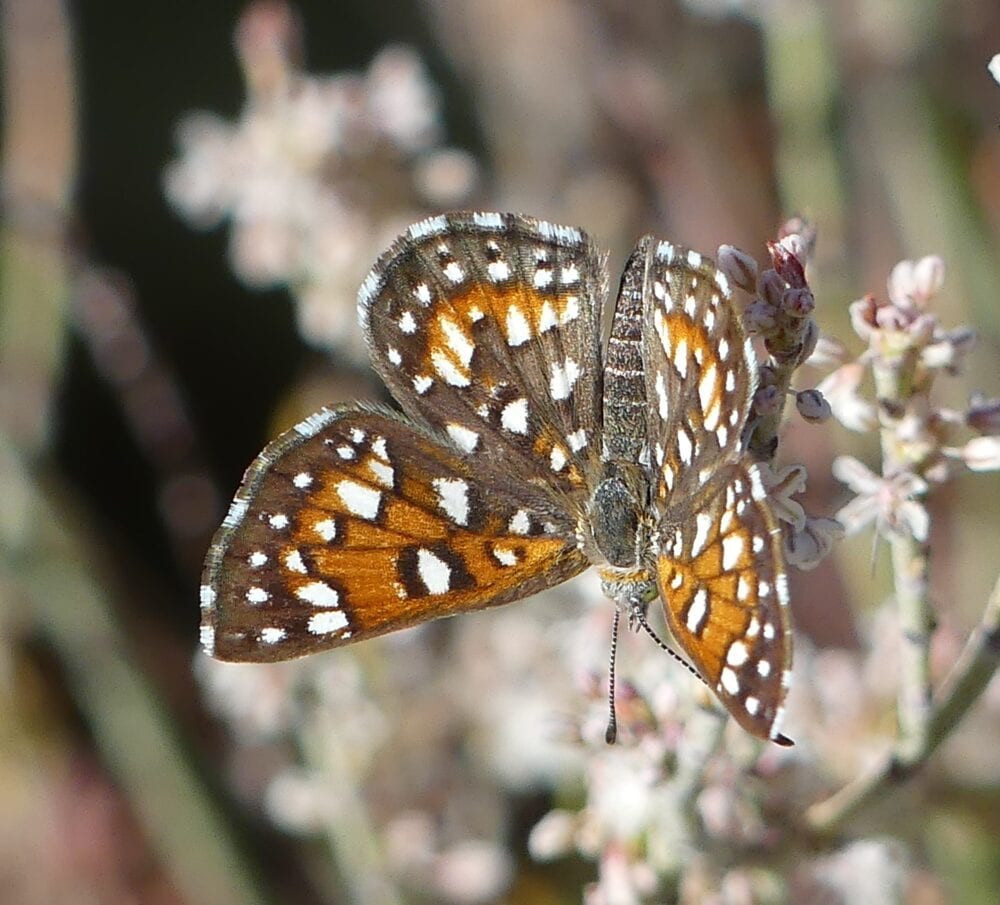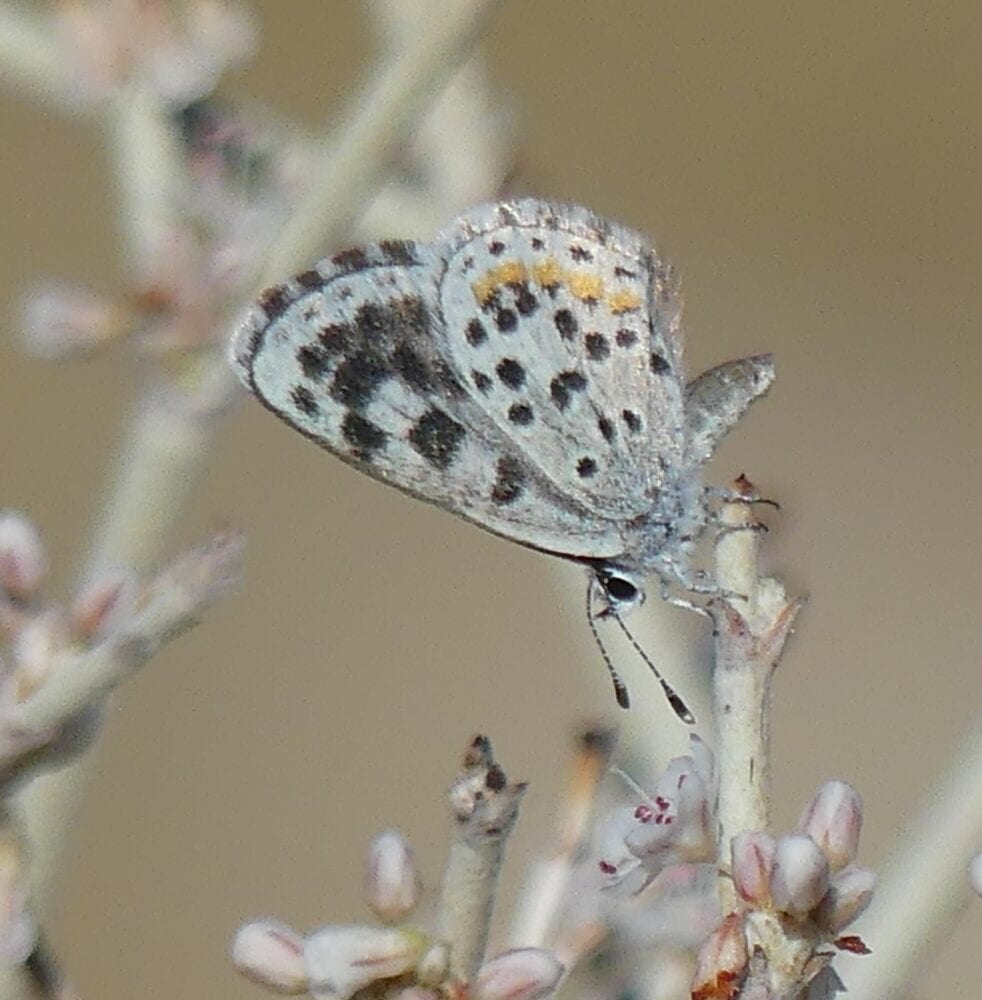Oct. 27, 2020
By Steven J. Cary
It sounds ridiculous now that winter has arrived, but things were different in September! Marcy and I wanted to get away from hot, dry Santa Fe for a few weeks, so we hitched up our travel trailer and camped our way west toward a rendezvous with her sister in San Diego. On our first night, October 1, we encamped at BLM’s Sand Island Campground, which is in southeast Utah along the San Juan River just downstream of Bears Ears National Monument. We had an experience there and, although no butterflies were involved, I have no choice but to share it with you.
After dinner and anticipating the rise of the Harvest Full Moon, we walked down to the north bank of the river and made ourselves comfortable for the proceedings. In the oncoming crepuscule, we watched a mule deer doe and two fawns emerge from the trees on the south bank of the river upstream from us. They walked to a noisy, channel-spanning riffle and proceeded to cross. The larger fawn followed mom step for step, its long legs keeping it dry and on course across the riffle. The smaller fawn trailed and struggled, its legs seemingly too short to keep its torso entirely above the water. The current gradually nudged it off-course and buoyed it off the riffle into the deep, fast water along the steep-sided north bank. Coming out of that chute, the fawn slowly swam then waded back onto the south bank where it started. As mom and sibling foraged in willows on the north side of the river, the little one set out again to cross at the noisy riffle. The results were the same, but this time it was noticeably barking or bleating as it emerged from the current and wobbled back up onto the south bank. In its third effort to ford the San Juan it was again floated off the riffle and into the fast current. By then darkness had enveloped the scene so we could neither see nor hear anything more.
We were unashamedly troubled by witnessing the young animal in distress, and also by not knowing the outcome. No fawn passed by us in the current, alive or dead. Perhaps it found purchase on the north bank above us and climbed out; perhaps mom was on-hand to offer encouragement. Perhaps we witnessed natural selection doing its merciless work. The ensuing moonrise was cold comfort for our bruised minds.
The next several nights we camped, toured and hiked in Bryce Canyon National Park, the Grand Canyon’s North Rim, and the adjacent Kaibab National Forest, where we saw a few actual butterflies. That drought plaguing New Mexico had been doing the same for Utah and Arizona as far as we could tell: sunny, hot, dry, and calm under high atmospheric pressure. Everywhere we went in low country, virtually all plant communities were shut down: brown, tan, crunchy, dormant. Insects of any kind were few and widely spaced. There were some exceptions in the higher terrain and along watercourses, but otherwise it was uniformly desiccated.
Our first butterfly adventure came after we had arrived at Marcy’s sister’s house in Palm Desert, CA, where it was a freaking 105°F! Ecosystems there (elevation 250 feet above sea level) were crunchy dry, too, but I suspect is normal for southern California’s Mediterranean climate. They receive no rain all summer because all frontal storms are steered far to the north. With summer almost over, October can be a transitional weather month there. Four years ago, almost to the day, Marcy and I were headed to Yosemite National Park, not all that far to the north, but we were delayed when a snowstorm closed Tioga Pass. There was no risk of that on this occasion!
Like New Mexico, California has a very diverse butterfly fauna, but with significant differences. Southern California is home to a number of species that I have never seen and am excited to eventually see and photograph. Before this trip I downloaded butterfly lists for San Diego County and neighboring counties, obtainable from ButterfliesandMothsofNorthAmerica or iNaturalist. Then I perused Glassberg’s 2017 Swift guide and annotated my SoCal list with flight times for each species, making special note of species that fly in October. Among the usual assortment of ho-hum species, two stood out as unusual, rare, or restricted in their range: California Giant-Skipper (Agathymus stephensi) and Dammers’ Dotted-Blue (Euphilotes enoptes dammersi). To get specific known localities for these critters, I went to BAMONA. I opened the page for each species, then went to the map, zoomed in, and clicked on dots that were near Palm Desert. As luck would have it, both were documented with mid-October dates about 20 miles south of town. Finding each would require finding stands of its host plants: agaves for the Giant-Skipper and wild buckwheats for the Dotted-Blue.
At 8:30 AM on Wednesday, October 14, with an odd mix of hope and low expectations, we went in search of these two butterflies. Would they be flying in this terribly hot, dry October? If they were flying, could we find them? We drove south on curvy State Highway 74 for about 17 miles, up into the Santa Rosa Mountains, then exited to the parking area for Cactus Spring Trail. This was within the San Bernardino National Forest, which had been closed to the public for a month and only opened a week earlier lucky for us. Things were very dry here, too, with essentially zero nectar and zero moist ground, so my expectations did not rise.
The Cactus Spring Trail was an old road that began at 4,000 feet elevation then aimed eastward into the Santa Rosa Wilderness, in the northern foothills of the Santa Rosa Mountains. The trail led us gently downslope toward Deep Canyon. The vegetation was dominantly scrub and chaparral, with some junipers and small oaks. A few larger trees lined the canyon bottom, while pines and other substantial trees grew much farther upslope. Chaparral habitats appeal to me because I can see a long distance, the plants are plainly evident, and the butterflies will be within relatively easy view (i.e., not in treetops). Also, chaparral habitats are fire-climax habitats, so they have some of the plants and butterflies (like hairstreaks, blues, coppers, metalmarks) that are of greatest interest to me.

As we walked, we could see a variety of agaves, yuccas, and sotols (I think), and it struck me that Giant-Skippers might be relatively insulated from drought because their larvae live, grow, and pupate inside the succulent, fleshy leaves of agaves, where the humidity is presumably high. Right about then a butterfly skipped past me. Unhurried, perhaps making its morning wake-up outing, it flew up a gentle, rocky slope and landed head-up on a tall agave stalk. Perhaps 10 feet off the ground and 20 feet away, it had to be a California Giant-Skipper. I followed the first rule for photographers when meeting a butterfly of interest: first, get a shot; OK, check, I got some shots. Part two of the rule: work to get better shots. My initial angle was edge-on, so I slowly walked to get a more perpendicular view, also hoping to put the sun behind me. I took a few steps, then more photos, then more steps. I did not try to close the distance, but better views work both ways; the skipper got a better view of me and took off. I watched it for a few seconds until it vanished. A few days later I submitted a photo to BAMONA and the California reviewer, Ken Davenport, confirmed its identity as California Giant-Skipper.
Quite happy to (presumably) have bagged one of my two targets so soon on a day with low expectations, I would have settled for that, but we still wanted to do a hike and get some exercise before it got too hot, so we might as well look for butterflies, like dotted-blues, too. Along the trail, wild buckwheats were common, at least two species that were unknown to me, but they were entirely gone to seed and showed their rust-red winter colors. Among them we soon spotted a member of the Mormon Metalmark complex, which uses buckwheats for their larvae. Like New Mexico, southern California has a handful of distinct named subspecies or other taxa within this complex, but their relationships remain largely inscrutable. I submitted dorsal and ventral shots to BAMONA and Ken Davenport responded within 24 hours that it was Behr’s Metalmark (Apodemia virgulti), which was known from that area, but a life species for me!

Sun and air temperatures continued to rise, but we continued on the trail, slowly descending toward the main canyon. Soon we reached the site of an abandoned mine of some kind, rather small, but showing the usual disturbed landscapes and abandoned, rusty equipment. A different species of wild buckwheat grew on the southeast side of the scrape and it appeared to be in “full bloom.” I use the quotes because these small, pale green, almost leafless shrubs were covered with white flowers, but the blossoms were so tiny I had to look twice to confirm that it was in bloom at all. Then my eye caught a small shape bobbing and weaving among the shrub’s peripheral branches, about knee-high. When it landed, its smeared ventral forewing black spots showed it was a Dotted-Blue. I hoped it would be Dammers’ but it was likely a new species (or subspecies) for me no matter what it was. Over about 20 minutes I saw several and took many photos of the host buckwheat. I saw only the dorsally dark females, though none offered a good dorsal view; males, presumably blue above, may have been easier to find a couple of weeks earlier.

A few days later, BAMONA’s California butterfly reviewer concurred that it was “probably” Dammers’ Blue, though it’s true identity would have to await DNA analysis of this group. One must accept that kind of uncertainty in the world of dotted-blues, whether in New Mexico or California. Ken did say that Nick Grishin’s lab is apparently hard at work trying to unravel relationships in this complex and fascinating group.
It felt odd to have both of my target species, plus the metalmark, in little more than an hour’s work. I was unaccustomed to such good fortune, but much of the credit goes to BAMONA, which showed me exactly where to go. Another major takeaway for me was that southern California harbors many species that would be new for me, and easy to find, if I can get to the right places at the right times.
Right about now you may be asking: why would a crusty old New Mexico butterflyer give a hoot about butterflies in other states, especially California? Isn’t that treasonous? Maybe, but each of these three California species has very close relatives (in the same genus) in New Mexico. Setting aside the undeniable thrill of the chase, this experience helped me see and understand New Mexico butterflies in a somewhat larger geographical context. As we sweated our way back to the truck, we could see several species of shrubs that had gone to seed, leading me to wonder what butterflopportunities the area might offer in other times of the year, particularly in spring after a wet winter. Time will tell!

Wonderful Steve and glad you not only saw the two butterflies got beautiful pictures. Thank you